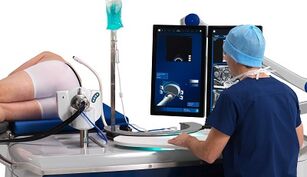Congestive prostatitis is a disease that occurs on the basis of dysfunction of the prostate gland. The main reason for the development of the disease is a stagnation in the prostate gland. A similar pathology can develop in men of any age. In recent times, cases of this disease detected in young people have become more frequent.
Reason

A buildup of the prostate always indicates the development of an inflammatory process that prevents the full functioning of the male prostate gland. The process of bleeding out becomes difficult, and the gland is no longer completely empty, so a secretory stagnation occurs.
Very often this disease develops against the background of chronic prostatitis. Therefore, the patient may not be aware of the presence of long standing processes in his or her body.
Prostate obstruction can happen for a variety of reasons. As a rule, the disease is not bacterial and manifests itself due to the influence of the following factors:
- Lack of constant intimate life. Frequent euphoria without subsequent ejaculation, inconsistent sex, incomplete ejaculation, frequent sexual intercourse after prolonged abstinence can lead to the appearance of a stagnant process.
- Anatomical features. If a person does not have enough venous valves or weakness of the venous walls of the urogenital plexus.
- Spinal injuries, as well as diseases such as herniated disc or bone necrosis. With physical damage to the spine, prolonged spasm of the prostate vessels can occur.
- Regularly lowering your body temperature, working in a room with air conditioning, drafts, etc. v.
- Bad habits - smoking, abuse of alcohol. As a result, the patient may experience paralysis of the small blood vessels of the genitourinary system.
- Chronic increase in temperature in pelvic organs. This phenomenon can also be attributed to anatomical features.
- Frequent colitis and diarrhea.
- Eating problems, dehydration.
According to most experts, the main cause of stagnation lies in the varicose veins of the lower extremities. In this case, there is a violation of blood circulation in the pelvic organs, since the prostate gland begins to fill with blood.
Usually, the cause of the disease can be a local inflammatory process in the pelvic or rectal organs. In addition, the disease can be caused by hormonal disorders.
Various acute or chronic infections can also cause stagnant processes in the prostate gland. The penetration of the infection into the prostate gland occurs through the urethra. In addition, the infection can be rectal, blood or lymphatic.
Who is at risk

Persistent sedentary work is a direct pathway to stagnant prostatitis.
Despite the fact that the disease develops suddenly, it can be prevented if provoking factors are excluded from everyday life. There is a risk of developing delayed processes in the prostate gland:
- People with sedentary lifestyles. First of all, we are talking about people who work while sitting.
- Patient has frequent constipation.
- People who eat erratically and neglect healthy, nutritious food.
- Smokers and heavy drinkers.
Symptoms
In most cases, this disease is characterized by an asymptomatic process, and therefore, it is almost impossible to determine its presence at home. The first sign of the disease is the appearance of pain in the perineum. It often gets worse when walking. However, the disease has certain symptoms, which need to be discussed in more detail.
The main symptoms of congestive prostatitis are:
- Reduced potency and libido. Impaired erection ability.
- Reduces semen count, consistency.
- Frequent premature ejaculation.
- Reduced orgasmic quality.
- A constant burning sensation in the urethra and bladder.
- Problems with urination, intermittent and painful urination.
- There are soreness in the groin extending to the sacrum or inner thigh.
- Frequent burning and discomfort in the bladder and urethra.
Nonspecific symptoms of congestive prostatitis include general weakness, decreased performance, sleep disturbances, and general irritability.
Category
At present, prostate congestion can be observed with the following types of prostatitis:
- Chronic.As a rule, it develops in the absence of a regular sex life or being replaced by masturbation. Obesity, interruption of intercourse, stress, poor blood supply, sedentary lifestyle - all of these factors ultimately lead to the development of chronic prostatitis. In chronic prostatitis, ejaculation is often secreted in the form of a lump. Prostate massage or intercourse may improve the patient's condition, but the effect will be shortened.
- Intravenous.Appears in the presence of pathology of the venous system. If the patient has varicose veins, due to an accumulation of venous blood in the venous system of the small pelvis, the stagnation process may also be localized in the prostate gland. The consequence of this is prostatitis.
- Festival.It occurs because parts of the prostate gland are not completely empty, so it is frequently in a state of blood flow, which contributes to the development of inflammation. Most often, this form of prostatitis occurs in middle-aged men.
- Contagious.In this case, the cause is an infection that gets into the prostate gland through the genitourinary system. If this happens to the background of the inflammatory prostate gland process, the inflammatory process increases and the general condition of the patient becomes worse.
Diagnosis

A prostate scan helps to accurately identify the picture of the disease.
Diagnostic measures necessarily include a palpation of the prostate gland, as well as an examination of the posterior urethra. This is the basis for the diagnosis of prostatitis, allowing the specialist to determine whether the sensitivity is low or high. In addition, the presence of a disease is demonstrated by the secretion of a meager sterile secretion.
Furthermore, if the doctor suspects the development of the disease, the patient will be sent for a prostate scan. This procedure is well tolerated by the patient, taking an average of about fifteen minutes. As a result of the rheology, it is possible to identify violations of outflow out of the veins, in order to obtain basic information about the state of the vessels - their elasticity and their integrity.
If the blood reaches the tissues of the gland is difficult, then this indicates the presence of degenerative changes.
To confirm the diagnosis and get more information, the following procedures will be applied:
- Ultrasound of the pelvic organs.
- X-ray of the prostate gland.
You cannot do without laboratory diagnostic methods, involving passing the following tests:
- Urine test.Includes general urine analysis, triplet studies and microbiological cultures. During this analysis, most pathogenic microorganisms, including chlamydia, are usually not detected.
- Blood test.We are talking about blood clots and blood clotting methods.
- Analysis of the secretions of the ejaculate and prostate gland.Usually, with congestive prostatitis, no leukocytosis is detected. However, the sample contained images of the cylindrical and squamous epithelium.
The difference between congestive and infectious prostatitis

The disease is accompanied by frequent depression in men.
At the diagnostic stage it is very important to distinguish a stagnant process from an infectious one. If not, the treatment will be incorrectly selected, which can lead to a number of complications. Therefore, the therapist should pay attention to the following symptoms:
- Problems with urination - usually, patients urinate a lot in the morning. Furthermore, his condition improved.
- Pain and burning sensation in the episiotomy and testicles.
- Fever accompanied by severe fatigue.
- General depression and anxiety.
- Erection problems and weak orgasm. Usually, the quality of the ejaculate is poorer in the patient, which can be detected in additional studies.
Initially, doctors conducted palpation studies, in which they revealed certain changes in the prostate gland. We can talk about the following features:
- expanded body;
- the contours of the prostate gland are very vague; The consistency of
- has changed;
- increased sensitivity;
- recognizes the smoothness of the contours of the mid-line.
Important!In the presence of the above symptoms, the patient shows no signs of infection in subclinical tests.
The bile of the prostate gland is characterized by a dense, prominent lumpy form. Similar changes are observed when massaging the prostate gland. In some cases, the patient himself can notice the appearance of lumps in the semen during ejaculation. This shows the development of a stagnant process.
Treatment
Treatment of illnesses includes quitting smoking altogether.
Treatment for congestive prostatitis is determined based on the degree of its manifestation. Based on a thorough diagnosis, the specialist determines the next course of treatment. As a rule, it assumes an integrated approach and includes the following procedures:

- Drug treatment.When treating prostate stasis, the patient needs anti-inflammatory drugs. The doctor may also prescribe other medications for his or her patient.
- Pain relievermay be prescribed for pain relief. They are often used with blood thinners.
- Source mode.When detecting hydrostatic prostatitis, the patient follows a strict diet that limits the intake of spicy and fatty foods. The key to rapid recovery is a balanced diet, when the patient's daily diet contains a large amount of fruits, vegetables, fermented dairy products and oils.
- Sex mode.It is very important that the patient not only adheres to sexual hygiene, but also improves his intimate life. Regular sex will normalize the prostate gland and eliminate the development of stagnant processes in the future.
- Get rid of bad habits.Many experts do not know how to treat congestive prostatitis with smoking or abuse of alcohol. It is very important that the patient quit smoking and drinking alcohol completely, which can cause the development of obstruction. Equally important is to minimize negative factors such as hypothermia, physical overload, inactivity, etc. v.
- Physical activity.Most therapists prescribe special physical therapy exercises for their patients. Such exercises are often aimed at strengthening the abdominal muscles, improving breathing, and toning the pelvic floor muscles.
- Vitamin therapy.This is a very important step in the treatment of congestive prostatitis. The patient's body must receive adequate nutrients. For this purpose, complex vitamins are often prescribed for congestive prostatitis.
If the cause of the development of congestive prostatitis in a man is due to valve defect in the lower limb veins, he must intervene with surgery.
Precautions
The basis of the precautions in this case is activity. Furthermore, it needs to be manifested both in motion and sexuality. Experts believe that, in order not to stagnate, the prostate gland must function regularly. Only ejaculation can provide this.
Moderate exercise, regular walking and a normal diet will help prevent the development of this disease.
























